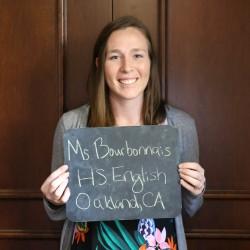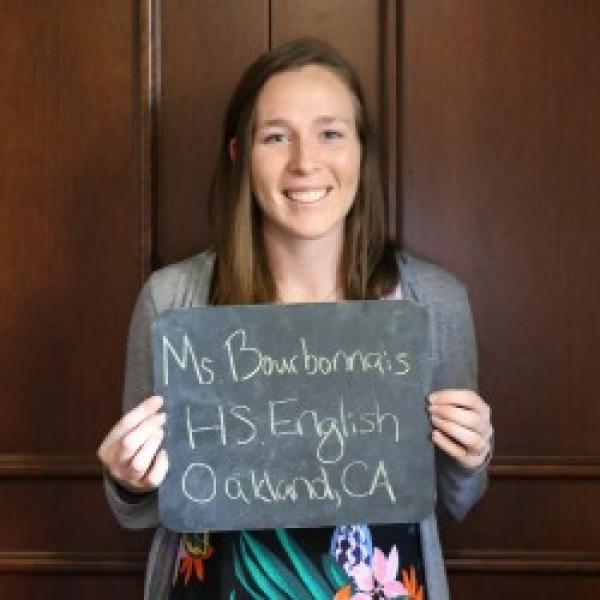Lessons in Literacy // Defend that Villain: Using Diary Entries to Spark Discussion in a High School Classroom
 For this installment of the Lessons in Literacy series, the CLE is pleased to spotlight an incredible educator, Anna Bourbonnais. Ms. Bourbonnais teaches high school English at Holy Names High School in Oakland, California. She graduated from the University of Notre Dame and is serving her second year as an ACE Teaching Fellow. She is a candidate for a Master's in Education from the University of Notre Dame.
For this installment of the Lessons in Literacy series, the CLE is pleased to spotlight an incredible educator, Anna Bourbonnais. Ms. Bourbonnais teaches high school English at Holy Names High School in Oakland, California. She graduated from the University of Notre Dame and is serving her second year as an ACE Teaching Fellow. She is a candidate for a Master's in Education from the University of Notre Dame.
Teachers will periodically contribute to the Lessons in Literacy series on the CLE blog. Through this series, teachers will periodically share their classroom successes and innovative ideas.

At times, my high school students struggle to unpack the social commentary veiled within a dense text, and I can't really blame them. Frankenstein. Anna Karenina. Hamlet. The Adventures of Huckleberry Finn. With the risk of getting bogged down by the complex language, these novels are difficult just to read and understand–let alone to analyze. It makes sense, then, that developing an understanding of the social critique or commentary packaged within these novels' pages is a challenge.

Students from Holy Names High School in Oakland, CA.
While I still work to find the best means by which to direct my students towards unpacking these hidden messages, I have started to find unlikely support from the villains of these novels. I use the term "villains" loosely because sometimes it is difficult to determine who the villain really is in each of these stories–and isn't that the point? The author of a complex text rarely portrays the villain as overtly grotesque; often the real evil is more subtle or insidious than that. True villains in our society often wander around our daily lives, reinforcing unfair societal standards or capitalizing on ideas and privileges taken for granted, and this is the type of villain that the author wants us to uncover. So, one of my favorite activities to do with my students is a quick diary entry from the perspective of a novel's physical villain or antagonist. Sometimes I'll use this strategy as a formal assessment for a lesson, but more frequently, I use it as an informal means to challenge students' understandings of character motivations and help guide them to the root of character actions. My favorite example of using these quick diary entries to spark class discussion comes from my Frankenstein unit.
 In Mary Shelley's novel Frankenstein, a young man named Victor Frankenstein brings to life a monster by sewing together corpses' body parts and electrocuting the patchwork body. As my students read the novel, it did not take long for them to make the connection that, because of his greed and lack of ownership for his actions, Victor Frankenstein may be more of a villain than the monster he created; however, getting them to dive deeper into the complexities of responsibility took a little more prodding. I wanted students to ask: Who is responsible for whom in society? How long are parents or guardians responsible for their children and to what degree? Who is responsible for the blame when individuals "mess up"–the individuals or their custodians?
In Mary Shelley's novel Frankenstein, a young man named Victor Frankenstein brings to life a monster by sewing together corpses' body parts and electrocuting the patchwork body. As my students read the novel, it did not take long for them to make the connection that, because of his greed and lack of ownership for his actions, Victor Frankenstein may be more of a villain than the monster he created; however, getting them to dive deeper into the complexities of responsibility took a little more prodding. I wanted students to ask: Who is responsible for whom in society? How long are parents or guardians responsible for their children and to what degree? Who is responsible for the blame when individuals "mess up"–the individuals or their custodians?
We had a breakthrough when, in a short bellwork assignment, my girls adopted the perspective of Frankenstein's monster after he murders William, Victor's brother. I told them to use the space as an opportunity for the monster to speak his piece and to justify his actions. What followed was an energetic discussion of whether or not the monster's defense would stand up in a court of law. Some students sympathized with the monster because of his unnatural origins and lack of a traditional upbringing, and others condemned the monster for his actions because of his proven intellectual awareness and independence. Finally, a student queried whether this was any different than a parent's responsibility for his or her child's actions, and we were off, spending a good thirty minutes debating the limits, if any, of real parents' responsibility for their children's actions in everyday life.
The assignment was a low-stakes opportunity for my students to take their thinking from their diary entries a step further and explore the impact of societal standards on characters. Through our discussion, students began to unpack how an author can use an antagonist to reveal a deeper message or pose a question to his or her audience. These "villainous" diary entries have become a staple in my classroom discussions, and I have loved seeing my students step into the minds of these unlikely literary heroes. I have heard from King Claudius, Huck Finn, Count Vronsky, Tom Buchanan, and Anna Karenina. Their voices are sometimes desperate but always rich and ready to explain how they are not the villain. These diary entries remind us that there is usually more to the villain than meets the eye, and we should (and can!) examine the text critically to understand their motivations.
Happy Reading,
Anna
